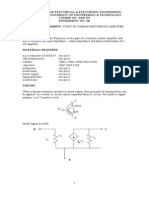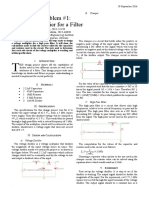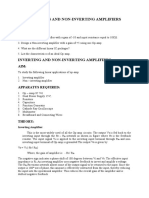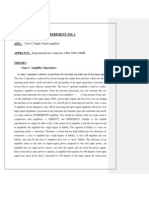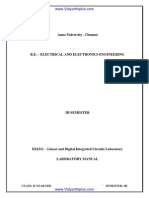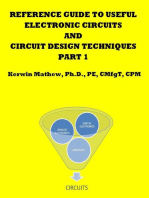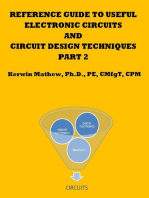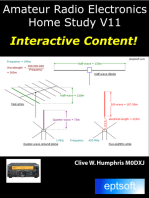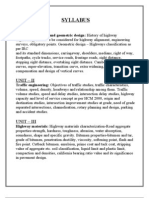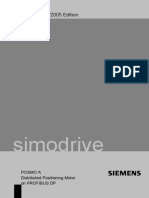Class A Power Amplifier Lab
Class A Power Amplifier Lab
Uploaded by
arupCopyright:
Available Formats
Class A Power Amplifier Lab
Class A Power Amplifier Lab
Uploaded by
arupOriginal Title
Copyright
Available Formats
Share this document
Did you find this document useful?
Is this content inappropriate?
Copyright:
Available Formats
Class A Power Amplifier Lab
Class A Power Amplifier Lab
Uploaded by
arupCopyright:
Available Formats
ECA Lab manual
3.CLASS A POWER AMPLIFIER(SERIES FED)
AIM: To design and test the class A power amplifier
APPARATUS:
1. Class A power amplifier trainer kit
2. Function Generator
3. CRO
4. BNC Probes and connecting wires
CIRCUIT DIAGRAM:
THEORY:
The amplifier is said to be class A power amplifier if the q point and the input
signal are selected such that the output signal is obtained for a full input cycle. For
this class the position of q point is approximately y at the midpoint of the load line. For
all the values of input signal the transistor remains in the active region and never
entire into the cutoff or saturation region. The collector current flows for 3600 (life
cycle) of the input signal in other words the angle of the collector current flow is
3600 the class a amplifiers or furthers classified as directly coupled and transformer
coupled and transformer coupled amplifiers in directly coupled type .The load is
directly connected in the collector circuit while in the transformer coupled type, the
load is coupled to the collector using the transformer.
Advantages:
1. Distortion analysis is very important
2. It amplifies audio frequency signals faithfully hence they are called as audio
amplifiers
Dept of ECE, Lendi Institute of Engineering and Technology Page 12
ECA Lab manual
Disadvantages:
1. H parameter analysis is not applicable
2. Due to large power handling the transistor is used power transistor which is
large in size and having large power rating.
PROCEDURE:
1. Switch ON Class –A power amplifier trainer
2. Set Vs (say 250 to 300 mV), at 10 KHz using signal generator.
3. Connect milli ammeter to the ammeter terminals
4. By keeping the input voltage constant, vary the frequency from 0 to 1MHz
in regular steps .
5. Note down the corresponding output voltage from CRO
6. Calculate the DC input power using the formula Pdc= VccIc
7. Calculate the AC output power using the formula Pac = VO2/8RL
8. Calculate the efficiency η = Pac /Pdc
9. Plot the graph between Gain (db) and frequency.
10. Calculate bandwidth from the graph.
PRECAUTIONS:
1. Check connections before switching ON power supply
2. Don’t apply over voltage
3. When you are not using the equipment switch them OFF.
4. Handle all equipment carefully.
CALCULATIONS:
Input power: Pdc= VccIc =
Outpower: Pac = VPP2/8RL =
η = Efficiency=output power/input power*100 = Pac /Pdc*100 =
Dept of ECE, Lendi Institute of Engineering and Technology Page 13
ECA Lab manual
EXPECTED GRAPH:
I/P:
O/P:
RESULT: Gain and frequency as observed of Class A power amplifier.
η = Efficiency=output power/input power*100 = Pac /Pdc*100 =
VIVA QUESTIONS:
1.On which criteria based the power amplifiers are classified?
2.what is the operating point of class-A power ampliier?
3.what is meant by efficiency?
4.howmuch efficiency will b obtained in classs-A power amplifier?
5. what are the applications of power amplifier?
REDRAW THE CIRCUIT DIAGRAM:
Dept of ECE, Lendi Institute of Engineering and Technology Page 14
You might also like
- Total Ionizing Dose Effects On Current Sense AmplifiersDocument4 pagesTotal Ionizing Dose Effects On Current Sense Amplifiersarup100% (1)
- Xentry Kit and Star Diagnosis Part 1Document56 pagesXentry Kit and Star Diagnosis Part 1arup100% (1)
- Toyota Maintanence Schedule PDFDocument10 pagesToyota Maintanence Schedule PDFcod22050% (2)
- Ecet Eca Lab ManualDocument47 pagesEcet Eca Lab ManualR RajenderNo ratings yet
- R-22 Eca Lab ManualDocument59 pagesR-22 Eca Lab ManualGovardhan NunetiNo ratings yet
- Wein Bridge Oscillator: f =1/2π√R1C1R2C2Document11 pagesWein Bridge Oscillator: f =1/2π√R1C1R2C2krishna goggiNo ratings yet
- Complementary Push Pull Power Amplifier LabDocument3 pagesComplementary Push Pull Power Amplifier LabarupNo ratings yet
- ECA ManualDocument62 pagesECA ManualAnonymous gP8ivl7fNo ratings yet
- ECE APCL LM Bat21 PDFDocument4 pagesECE APCL LM Bat21 PDFganga bhavaniNo ratings yet
- Eca Lab-Manual PDFDocument87 pagesEca Lab-Manual PDFdedoga9086No ratings yet
- Nollido Acee6l Exp6 Ee2hDocument10 pagesNollido Acee6l Exp6 Ee2hrusselpagaoNo ratings yet
- Lab ManualDocument38 pagesLab ManualsivaNo ratings yet
- ClasssA AmpDocument7 pagesClasssA AmpRamNo ratings yet
- Amplifiers and OscillatorsDocument109 pagesAmplifiers and OscillatorsAdilNo ratings yet
- Long ReportDocument14 pagesLong ReportNur Hadi NorazmanNo ratings yet
- iNTERGRATOR AND DIFFERENTIATOR OP amoDocument10 pagesiNTERGRATOR AND DIFFERENTIATOR OP amoNYONGESA CephasNo ratings yet
- Electronic Circuits 1 Ec1203Document13 pagesElectronic Circuits 1 Ec1203ainugiri100% (2)
- Dar Es Salaam Institute of Technology: Department: Module CodeDocument14 pagesDar Es Salaam Institute of Technology: Department: Module CodeSokoine Hamad DenisNo ratings yet
- Eca Lab-Min PDFDocument87 pagesEca Lab-Min PDFAkashita SharmaNo ratings yet
- World University of Bangladesh: Department of Electrical and Electronic Engineering Course Name: Electronics II LabDocument3 pagesWorld University of Bangladesh: Department of Electrical and Electronic Engineering Course Name: Electronics II LabshajibNo ratings yet
- AC Machines Lab ManualDocument52 pagesAC Machines Lab ManualmitulNo ratings yet
- Expt 6Document3 pagesExpt 6sabitavabiNo ratings yet
- Ex05 Lim OpampDocument9 pagesEx05 Lim OpampLIM Sheryl M.No ratings yet
- Eca Lab ManualDocument78 pagesEca Lab ManualNageswariah.MNo ratings yet
- Eca Lab ManualDocument158 pagesEca Lab ManualRamarao Gude50% (2)
- RC Coupled Amplifier LabDocument5 pagesRC Coupled Amplifier LabarupNo ratings yet
- Electronic Devices Lab - Exp - 7 - Student - Manual (Summer 18-19)Document4 pagesElectronic Devices Lab - Exp - 7 - Student - Manual (Summer 18-19)MD MONIM ISLAMNo ratings yet
- TWO STAGE RC Coupled AmplifierDocument3 pagesTWO STAGE RC Coupled Amplifierfarzana kousar100% (2)
- Lab # 11 Power Amplifier: Class-ADocument8 pagesLab # 11 Power Amplifier: Class-ARaja SaifNo ratings yet
- EEE 54 DP1 Documentation - Mendoza - SorianoDocument2 pagesEEE 54 DP1 Documentation - Mendoza - SorianoDarl John MendozaNo ratings yet
- AEC LabManualDocument30 pagesAEC LabManualPrateek PaliwalNo ratings yet
- EEE 2104 Lab Report 08Document7 pagesEEE 2104 Lab Report 08shohim603No ratings yet
- 2 Two Stage RC Coupled AmplifierDocument7 pages2 Two Stage RC Coupled AmplifierdamasNo ratings yet
- Experiment No 1 AM TransmitterDocument6 pagesExperiment No 1 AM TransmitterashfaqiNo ratings yet
- Eca Digital Notes Final 2023-24Document95 pagesEca Digital Notes Final 2023-24iicavnietNo ratings yet
- Ecs Cycle 2Document16 pagesEcs Cycle 2sreeachyut55200No ratings yet
- Department of Electronics &communication Engineering: B C Co BEDocument11 pagesDepartment of Electronics &communication Engineering: B C Co BEKishoth kumar.ANo ratings yet
- Op Amp Adder and IntregatorDocument5 pagesOp Amp Adder and IntregatorAshish100% (2)
- Ao Lab Report 5Document7 pagesAo Lab Report 5Umar Ali BaigNo ratings yet
- Exp No 1. Class-A Power Amplifier: TheoryDocument3 pagesExp No 1. Class-A Power Amplifier: TheorySubham GhoshNo ratings yet
- Ee 352 Ec Ii LabDocument61 pagesEe 352 Ec Ii LabSatya SandeepNo ratings yet
- Inverting and Non-Inverting Amplifiers: Pre-Lab QuestionsDocument13 pagesInverting and Non-Inverting Amplifiers: Pre-Lab QuestionsBereket TsegayeNo ratings yet
- CT LMDocument44 pagesCT LMNikhil KolheNo ratings yet
- EC I 2marks PDFDocument13 pagesEC I 2marks PDFPetrishia ArockiasamyNo ratings yet
- Unit7-NAN 2Document38 pagesUnit7-NAN 2Anser PashaNo ratings yet
- Electronic Circuits I 2 Marks Question AnswersDocument13 pagesElectronic Circuits I 2 Marks Question Answersbala_smNo ratings yet
- EC Lab Manual (08.407)Document101 pagesEC Lab Manual (08.407)Assini HussainNo ratings yet
- EE6311 LIC Lab - VidyarthiplusDocument66 pagesEE6311 LIC Lab - VidyarthiplusArun KumarNo ratings yet
- Half Wave Rectifier and Full Wave RectifierDocument4 pagesHalf Wave Rectifier and Full Wave Rectifierjosephmathewt98No ratings yet
- Lab 1 Class C Amplifier PDFDocument2 pagesLab 1 Class C Amplifier PDFআব্দুল্লাহ আল ইমরান100% (1)
- IC Lab MaualDocument59 pagesIC Lab MaualKumar Goud.K100% (2)
- Experiment 3 - Common Emitter AmplifierDocument6 pagesExperiment 3 - Common Emitter AmplifierAsyraf Norahairuzan100% (1)
- Rod Exp1Document2 pagesRod Exp1Reggie PalaganasNo ratings yet
- Reference Guide To Useful Electronic Circuits And Circuit Design Techniques - Part 1From EverandReference Guide To Useful Electronic Circuits And Circuit Design Techniques - Part 1Rating: 2.5 out of 5 stars2.5/5 (3)
- Reference Guide To Useful Electronic Circuits And Circuit Design Techniques - Part 2From EverandReference Guide To Useful Electronic Circuits And Circuit Design Techniques - Part 2No ratings yet
- Design of Electrical Circuits using Engineering Software ToolsFrom EverandDesign of Electrical Circuits using Engineering Software ToolsNo ratings yet
- Amateur Radio Electronics on Your MobileFrom EverandAmateur Radio Electronics on Your MobileRating: 5 out of 5 stars5/5 (1)
- To Whom So Ever It May Concern: Nov 2020 at Royal Garden, Vikasnagar Dehradun (UK) Pin 248198 According To Hindu VedicDocument9 pagesTo Whom So Ever It May Concern: Nov 2020 at Royal Garden, Vikasnagar Dehradun (UK) Pin 248198 According To Hindu VedicarupNo ratings yet
- TIA PatentDocument14 pagesTIA PatentarupNo ratings yet
- Analog and Mixed Signal Circuit Design Techniques in Flexible Unipolar a-IGZO TFT Technology Challenges and Recent TrendsDocument14 pagesAnalog and Mixed Signal Circuit Design Techniques in Flexible Unipolar a-IGZO TFT Technology Challenges and Recent TrendsarupNo ratings yet
- Sub: Approval of Extra Jurisdiction Journey To Accompany Students On Their Plant Visit at Mercedes-Benz PuneDocument3 pagesSub: Approval of Extra Jurisdiction Journey To Accompany Students On Their Plant Visit at Mercedes-Benz PunearupNo ratings yet
- United States Patent: CA (US) Shouri Chatterjee, New 2733272 g1 2588 (1) Beige 341/59Document14 pagesUnited States Patent: CA (US) Shouri Chatterjee, New 2733272 g1 2588 (1) Beige 341/59arupNo ratings yet
- Time TableDocument7 pagesTime TablearupNo ratings yet
- 2ND Training ListDocument5 pages2ND Training ListarupNo ratings yet
- Arpit Silver Arrows Rama RoadDocument13 pagesArpit Silver Arrows Rama RoadarupNo ratings yet
- Hall SensorDocument22 pagesHall SensorarupNo ratings yet
- Weekly - Report - 07-08-21 - ARUP BHAUMIKDocument4 pagesWeekly - Report - 07-08-21 - ARUP BHAUMIKarupNo ratings yet
- 24 DEC 2020 ADAM Result Sheet - 2020Document6 pages24 DEC 2020 ADAM Result Sheet - 2020arupNo ratings yet
- Page No Particular Date Bill No Amount (RS)Document11 pagesPage No Particular Date Bill No Amount (RS)arupNo ratings yet
- Automotive Fuel Level IndicatorDocument3 pagesAutomotive Fuel Level IndicatorarupNo ratings yet
- Variable Valve Timing (VVT)Document27 pagesVariable Valve Timing (VVT)arupNo ratings yet
- Male: Female:: Application FormDocument2 pagesMale: Female:: Application FormarupNo ratings yet
- Mechanical QuestionsDocument6 pagesMechanical QuestionsarupNo ratings yet
- Example - Practical Task 2Document1 pageExample - Practical Task 2arupNo ratings yet
- Electrical QuestionsDocument6 pagesElectrical QuestionsarupNo ratings yet
- Exhaust Aftertreatment Bluetec With Adblue: Insert Picture of Size 215X149 MM On Specified PageDocument50 pagesExhaust Aftertreatment Bluetec With Adblue: Insert Picture of Size 215X149 MM On Specified Pagearup100% (2)
- Advisory 2019Document17 pagesAdvisory 2019arupNo ratings yet
- BMW India CSR Policy V2.PDF - Asset.1633331834130Document9 pagesBMW India CSR Policy V2.PDF - Asset.1633331834130arupNo ratings yet
- Winterscape With Ads 2019Document12 pagesWinterscape With Ads 2019api-501678490No ratings yet
- List of Emc Tests Un Ece r10 Rev.6Document4 pagesList of Emc Tests Un Ece r10 Rev.6mirassouNo ratings yet
- Csep RC#42Document3 pagesCsep RC#42ashish kumarNo ratings yet
- Download ebooks file Essentials of Pharmacology for Nurses 4th Edition Paul Barber all chaptersDocument66 pagesDownload ebooks file Essentials of Pharmacology for Nurses 4th Edition Paul Barber all chaptersrihlacheruy100% (3)
- Reaserch PaperDocument43 pagesReaserch PaperSushant Sharma100% (1)
- Product Sheet GSM-5140Document1 pageProduct Sheet GSM-5140Kebo ElhaqNo ratings yet
- C2 W1 MergedDocument286 pagesC2 W1 Merged1SI20CS076 PRADEEP H VNo ratings yet
- Acti9 Ic60 Catalogue PDFDocument124 pagesActi9 Ic60 Catalogue PDFDionysios KoutsouvelisNo ratings yet
- Jaguar XJ 2008 INTDocument56 pagesJaguar XJ 2008 INTAlpaladi PaladNo ratings yet
- Khalifa Sheikh Ishaka Rabiu College: Endof3 TERM EXAMINATION 2020/2021 Subject:Hausa Class:Primary 2Document24 pagesKhalifa Sheikh Ishaka Rabiu College: Endof3 TERM EXAMINATION 2020/2021 Subject:Hausa Class:Primary 2shahadah connectNo ratings yet
- Palden Lhamo (Dpal Ldan Lha Mo) in Her "Dpal Ldan Dmag Zor Rgyal Mo" Form (Document4 pagesPalden Lhamo (Dpal Ldan Lha Mo) in Her "Dpal Ldan Dmag Zor Rgyal Mo" Form (Julia Abril100% (1)
- 88C46-D PR DS PRO-port-1 Pro5150Document108 pages88C46-D PR DS PRO-port-1 Pro5150Daniel Lazo PallautaNo ratings yet
- SYLLABUSDocument3 pagesSYLLABUSSyed Sirajul Haq100% (1)
- Oxygen Toxicity: January 2006Document11 pagesOxygen Toxicity: January 2006Dana, BNNo ratings yet
- Topics NO No of Hours Marks Weightage in ExamDocument8 pagesTopics NO No of Hours Marks Weightage in ExamSaeed cecos1913No ratings yet
- Sendup Paper 2023Document5 pagesSendup Paper 2023ayeshasaleem0617No ratings yet
- SIMODRIVE POSMO A Distributed Positioning Motor On PROFIBUS DP ManualDocument296 pagesSIMODRIVE POSMO A Distributed Positioning Motor On PROFIBUS DP ManualMikael PaivaNo ratings yet
- Icmr STSDocument9 pagesIcmr STSRomelu MartialNo ratings yet
- STK4048 AF Power Amplifier (Split Power Supply) (150W Min, THD 0.008%)Document8 pagesSTK4048 AF Power Amplifier (Split Power Supply) (150W Min, THD 0.008%)21210606100% (2)
- Mild Steel Solid Mig Wire MSDSDocument2 pagesMild Steel Solid Mig Wire MSDSsalcabesNo ratings yet
- The Great Paradise of Baturraden Village and Surrounding Area For Geoheritages and Geotourism Potential of Banyumas, CeDocument29 pagesThe Great Paradise of Baturraden Village and Surrounding Area For Geoheritages and Geotourism Potential of Banyumas, CeVicho RamadhanNo ratings yet
- Fractures and Principles in Management (Thari Raman - S Conflicted Copy 2016-05-07Document59 pagesFractures and Principles in Management (Thari Raman - S Conflicted Copy 2016-05-07Suganeya UdiasoorianNo ratings yet
- National Engineering Handbook - Part 645 - Construction Inspection - Appendix B - WorksheetsDocument216 pagesNational Engineering Handbook - Part 645 - Construction Inspection - Appendix B - WorksheetsPatrick Joseph RoblesNo ratings yet
- Ch1 IntroductionDocument22 pagesCh1 IntroductionKhaiRul FaiSalNo ratings yet
- Microlok II System Startup, Troubleshooting, and MaintenanceDocument207 pagesMicrolok II System Startup, Troubleshooting, and MaintenanceJay JayNo ratings yet
- DE50AV Horizonal Auger Packer Brochure 2016 PDFDocument18 pagesDE50AV Horizonal Auger Packer Brochure 2016 PDFJoão BaptistaNo ratings yet
- History of Bellakar: Adapted and Modified From Bellakar (2001) by Eric DubourgDocument11 pagesHistory of Bellakar: Adapted and Modified From Bellakar (2001) by Eric DubourgFabien WeissgerberNo ratings yet
- 08 Quite InformativeDocument2 pages08 Quite InformativeQazi BaranNo ratings yet
- A Jungian Interpretation of The Little Prince: Sara Setayesh, PHD Candidate, Shiraz University, International DivisionDocument8 pagesA Jungian Interpretation of The Little Prince: Sara Setayesh, PHD Candidate, Shiraz University, International DivisionDinah Jane MartinezNo ratings yet





















